Anti-tank grenade launcher PIAT (UK)
The reasons for the appearance of the new model anti-tank grenade launcher were simple. At the initial stage of World War II, the British infantry had only two means of combating tanks enemy: anti-tank gun Boys and rifle grenade number 68. Such weapons were used quite actively for a long time, but their effectiveness was constantly falling. Over time, the gun and grenade almost completely lost their potential in the fight against enemy armored vehicles and could no longer be considered as full-fledged anti-tank systems. The army needed some new weapons, the characteristics of which would meet the requirements of the time.

General view of the PIAT grenade launcher. Grenade installed, there is a fry. Photo of Wikimedia Commons
By this time, the British gunsmiths had accumulated some experience in the creation of anti-tank weapons. So, from 1940, Lieutenant Colonel Stuart Blacker worked on the “bombardment” of his own design. The Blacker Bombard product was supposed to damage the enemy’s armored vehicles with high-explosive ammunition of adequate power, but this seriously limited the characteristics of the weapon. Learning about developments in the field of cumulative ammunition, S. Blacker proposed a new version of his weapon, distinguished by a simplified and lightweight design. By reducing the size and weight of the new weapons could shoot from the shoulder.
The forces of Lieutenant Colonel Blacker formed the original appearance of a promising weapon, which meant launching anti-tank ammunition with the help of a guide-trench and a propellant powder charge. In addition, the project proposed some ideas and solutions concerning other features of the weapon design. By analogy with the previous project, the new weapon was given the working title Baby Bombard.
The first version of the hand grenade launcher was developed by the middle of the 1941 year. In the summer they produced a prototype weapon and a certain amount of trial ammunition for it. During the test, it was found that the proposed design of the weapon and projectile does not meet operational requirements. First of all, there were problems with fuses: they did not work, because of which the grenades did not have any impact on the target.
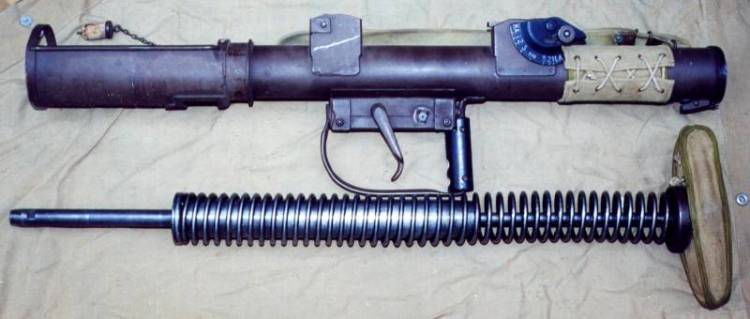
Incomplete disassembly of the grenade launcher, extracted from the case of the combat spring, the drummer and the butt stem. Photo Canadiansoldiers.com
After the failure of the Baby Bombard project, S. Blacker was transferred to a new job, and the further development of this weapon was entrusted to Major Millis Jeffreys. It was Major Jeffries who completed the development of the original project and improved the grenade launcher, which allowed him to pass all the necessary tests and become the weaponry of the British infantry. It should be noted that a change in project developer later became a cause for controversy. The military department later had to decide on the remuneration of two designers. Both officers were directly related to the creation of a new project, and therefore could expect to receive the award due. By the time S. Blacker left, the 50 ’thousand pounds sterling had left the project (about 1,95 million at current prices). Later, after adopting a grenade launcher, the lieutenant colonel received an additional award in the amount of 25 thousands (973 "modern" thousands).
Initially promising grenade launcher had the working title Baby Bombard, referring to the previous project of Lieutenant Colonel Blacker. After his transfer to a different design organization, a new name appeared - Jefferis Shoulder Gun (“Jeffrey's Shoulder Gun”). Having adopted a grenade launcher for service, the army gave it its own name. Now it was officially called PIAT (Projector, Infantry, Anti-Tank - “Infantry Anti-Tank Grenade Launcher”). Interestingly, at the beginning of 1943, the official name of the weapon was criticized by Winston Churchill himself. The Prime Minister demanded an explanation of why the new weapon was called a faceless abbreviation, and not the designer’s name. However, the weapon was not renamed and, as a result, it became widely known under the official name PIAT.
In the early stages of development, a promising grenade launcher was viewed as a profound modernization of the Blacks Bombards, characterized by reduced size and weight. Subsequently, the ideas of the original project underwent major changes, as a result of which the PIAT product lost any noticeable similarity with the basic design. In fact, the only idea that was transferred from an older project to a new one was to use the so-called. barreled ammunition: the grenades for the PIAT should have a tubular shank interacting with the grenade launcher rod.
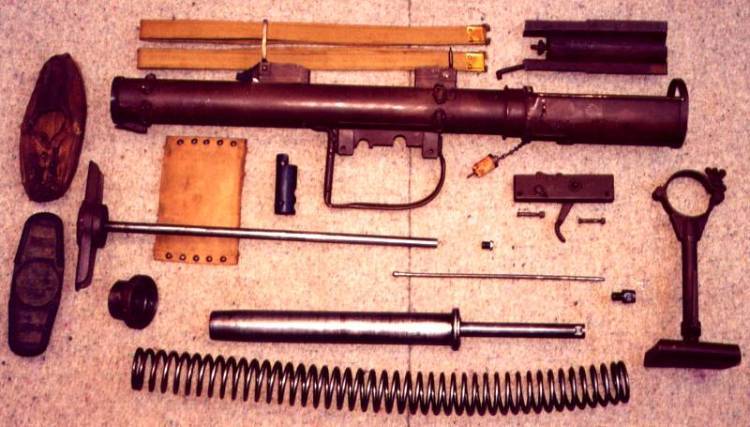
Complete disassembly. Photo Canadiansoldiers.com
The basis of the design of the PIAT grenade launcher was a tubular body, inside which were placed automation parts. Outside, other aggregates joined him. The case had a diameter of 83 mm, in front of it was attached a groove guide, made in the form of a pipe with the missing upper section. This device was designed to hold the grenade in the desired position and prevent its damage. The collar connecting the gutter and the pipe had attachments for mounting the bipod. From below, the case of a trigger mechanism with a characteristic croup strap joined the case. On the left surface of the pipe were sighting devices. The rear end of the body was covered with a back plate.
The internal structure of the grenade launcher was quite simple. The front end of the body had a round cap, in the center of which was a tubular stem. A needle head of a drummer was supposed to move inside this part. The drummer itself was made in the form of a massive metal cylinder with a striking needle at the front end. The back end of the drummer had to interact with the mainspring. On its lower surface there was a notch for interaction with the sear. The drummer had a mechanical connection with the bolt connected to the butt pad. With the help of this thrust it was proposed to carry out the cocking of mechanisms.
To control the shooting it was proposed to use a fairly simple trigger. On the bottom surface of the case there was a rectangular casing inside which a system of several levers was placed. There was a large trigger, covered with a large safety bracket. Turning the trigger led to the shifting of the sear and unblocking the spring-loaded drummer. No means of blocking mechanisms were used.
The grenade launcher of the construction of Blacker-Jeffreys received simple sighting devices, the basis of which served as metal sheets fixed on the left surface of the body-pipe. A folding front was hinged on the front base, and a rear sight on the back. Grenade launchers of different series could have a single-purpose vehicle with several holes, designed for firing at a different range, or be equipped with a limb with appropriate markings. The sight allowed to fire at ranges from 50 to 100 yards (45-91 m).
For more convenience, the grenade launcher could be equipped with a bipod with one or two legs. Regardless of the design, the bipod was fixed in front of the case. An additional means of improving ergonomics was a rubber pad on the back plate, reducing the impact of recoil on the arrow.
The PIAT grenade launcher had a total length of 990 mm with a maximum diameter of about 90 mm. To reduce the transverse dimensions in the transport position should be folded sights. Other protruding units were stationary and could not move. The total weight of the product without a grenade was 14,5 kg.
Already in the early stages of the project, S. Blacker developed the original design of an armor-piercing ammunition for a grenade launcher of the new model. Later M. Jeffreys improved this product, the result of which was the emergence of ammunition recommended for adoption. In the course of finalizing the project, we managed to get rid of a number of characteristic problems, resulting in obtaining the required characteristics.
The grenade launcher was supposed to use ammunition with a shaped charge. There was a main body with a concave head fairing, inside which was a charge of mass 1,1 kg. Behind the main body was attached a tubular shank, on which there was a stabilizer in the form of three planes and an annular device. Inside the tube it was proposed to place a sleeve with a propelling charge. The total mass of the grenade was 1,5 kg, the maximum diameter was 83 mm. Estimated armor penetration reached 100 mm. Transport shells offered by various devices. In particular, it is known about the existence of a pack with several tubes-cells.
The grenade launcher of the construction of Blacker-Jeffreys had an original operating principle. Other manual anti-tank systems of the time used the jet principle of throwing ammunition, while the PIAT was a launcher launcher. As a result, the preparation of the weapon for firing and the process of the shot should have looked different. At the same time there were some advantages over analogues.
To prepare the weapon for firing it was necessary to turn the back plate to a small angle, unlocking it. Then the grenade thrower had to, with his feet on the butt pad, pull the trigger guard. Dilution of the butt plate and hull in different directions led to the compression of a powerful mainspring and staging of a drummer on a platoon. After that, the back plate returned to its place. It should be noted that for cocking the existing spring, serious efforts were required. After cocking the spring and the drummer, it was necessary to place the grenade in the tray and put it on the stem with the shank. Next was aiming and pointing weapons.
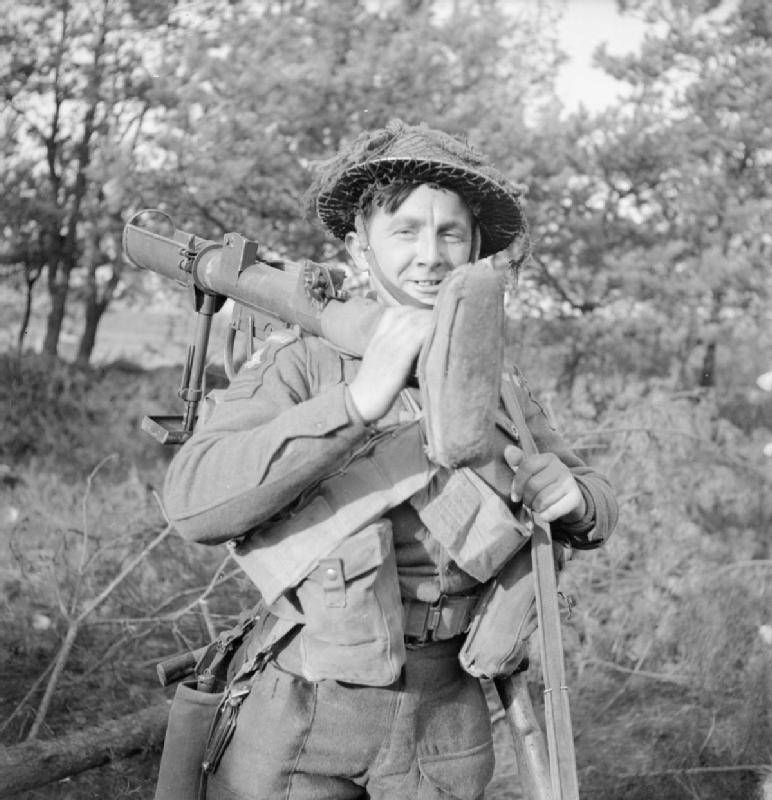
Grenade thrower with PIAT. UK War Office Photos
Pressing the trigger led to the shift of the sear and the release of the drummer. Under the action of a powerful mainspring, he went forward, while his striker passed through the rod and beat on the priming charge cap. Under the action of powder gases projectile had to fly to the target. The gases also affected the drummer, forcing him to roll back and compress the mainspring. In the rearmost position, the drummer was fixed with a sear, which made it possible to install a new grenade and execute the next shot.
During the tests, the PIAT grenade launcher found that the direct shot range reached 110 m. When firing at high elevation angles, it was possible to obtain the range 300-350 m, but in this case it was not necessary to rely on acceptable accuracy of impact. A further increase in the firing range was excluded due to the specifics of the grenade throwing method used. The warhead of the projectile punched up to 100 mm of homogeneous armor, but various factors could affect the real characteristics. The obtained parameters confirmed the possibility of using a grenade launcher by the army.
Some of the flaws of the weapon were noted, primarily related to the not very successful ergonomics. Thus, the combination of a relatively large length of the hull and the power of the mainspring led to the fact that the short stunner could experience certain difficulties in cocking the weapon. In combat conditions, the fighter would have to cocked the weapon in a sitting or lying position, which was also a noticeable problem. Ever since the first experiments of S. Blacker, the PIAT grenade launcher has remained a flaw in the form of strong recoil. Theoretically, such a weapon could be used by one soldier, but still there was a recommendation to introduce into the calculation the second fighter who was supposed to carry ammunition.
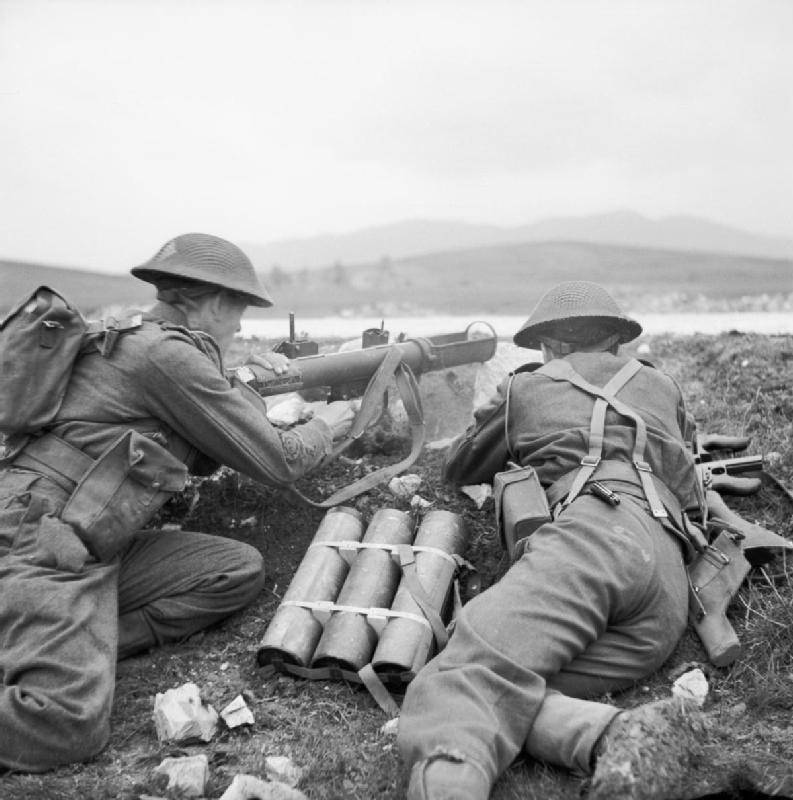
The calculation of the grenade launcher in the firing position. Between the fighters is a pack for carrying grenades. UK War Office Photos
New weapons had certain technical and technological advantages. The grenade launcher was extremely simple to manufacture and did not impose special requirements on technologies and materials. The proposed gang layout allowed further development of grenades in the direction of increasing mass and charge. In addition, unlike other manual anti-tank systems of its time, the PIAT did not emit reactive gases, which made it less dangerous for others, and also allowed it to fire from the premises.
The development and testing of a promising hand-held anti-tank grenade continued throughout the 1942 year, after which it was recommended for use. The corresponding order appeared in 1943 year. By the middle of the year, it was possible to start mass production and transfer the first batch of products to the customer. The serial production of PIAT grenade launchers continued until the 1944 year. During this time, the industry has manufactured 115 thousand grenade launchers. Grenade production was stopped only in 45, making a total of more than 7,5 a million pieces.
The army of Great Britain became the starting customer of the newest weapon. Soon new batches of serial grenade launchers began to be sent to the armies of the countries of the British Commonwealth. In total, the PIAT was delivered to almost 15 armies and resistance movements. One of the operators of these systems was the Red Army, which received, according to the Lend-Lease, 1 thousand grenade launchers and 100 thousand projectiles. Delivery volumes and the number of customers were such that the Blacker-Jeffreys grenade launchers managed to take part in the battles in all the theaters of war where Commonwealth countries were present, as well as some partisan movements. According to reports, the fighters of the Canadian troops were the first to use new weapons during the landing in Sicily in 1943.
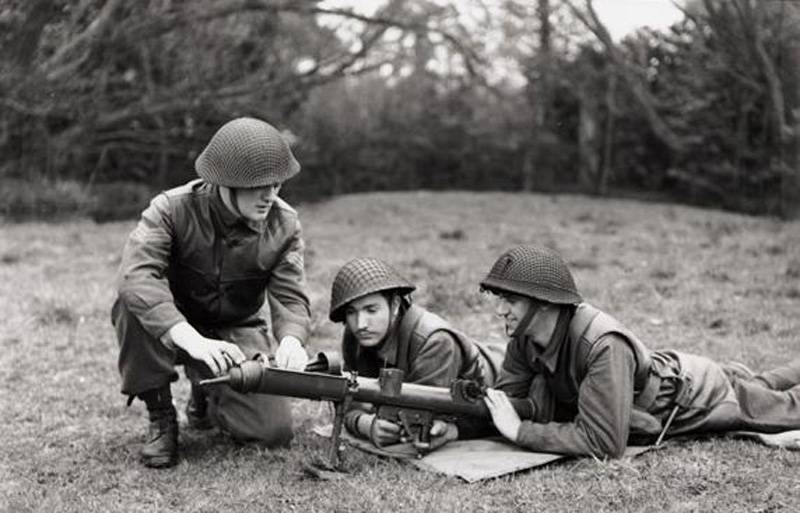
Sergeant D. Wilson, Private J. Brunnell and Private A. Munro (Canadian Light Infantry Regiment of the Highlanders) on the exercises in the UK mastering the PIAT grenade launcher, 13 April 1944. Photo Canadiansoldiers.com
In the early summer of 1944, Great Britain took part in the landing in Normandy. One of the main anti-tank weapons of the army at that time was the PIAT grenade launchers. Later it was found that such weapons accounted for 7% of damaged or destroyed enemy tanks. For comparison, aviation was able to disable only 6% of the armored vehicles. However, in the future, the effectiveness of cumulative grenades decreased. German tanks began to be equipped with additional screens, which almost completely eliminated the defeat of the machine with existing ammunition.
The gradual decline in real efficiency, combined with characteristic flaws over time, became a reason for criticism. However, for a long time the PIAT grenade launcher enjoyed a well-deserved fame. For example, in 1944-45, the Canadian army conducted a survey of several dozen officers who participated in the battles. The purpose of the survey was to establish the real capabilities of the weapon. According to the results of research, the PIAT grenade launcher was recognized as the most successful and effective weapon used by the troops.
Of particular interest is the operation of British grenade launchers by European partisan formations. A significant number of such weapons were transported in one way or another by the French and Polish Resistance. In the conditions of the impossibility of obtaining and using full-fledged artillery weapons, lightweight grenade launchers were of particular interest to the partisans. Such a weapon could be a decisive and uncontested argument in the fight against enemy armored vehicles.
As the Second World War continued, not only anti-tank weapons developed, but also the tanks themselves. As a result, the effectiveness of existing grenade launchers was constantly decreasing. By the end of the war, the PIAT product could not fight a significant part of the existing German armored vehicles. Because of this, the use of grenade launchers gradually declined in favor of more efficient systems, including foreign production. The Blacker-Jeffreys grenade launcher remained in service, but was used less and less.
After the end of World War II, the British Army did not immediately abandon the existing anti-tank grenade launchers. This weapon remained in service until the early fifties. Similarly, the situation was in the countries of the British Commonwealth. In the future, grenade launchers were written off and disposed of or sold to third countries. Some weapons got into Israel. It was the Israeli troops who last used the PIAT in combat. The last shots from this weapon outside the landfills occurred in the 1948 year, during the war of independence.
After decommissioning, the grenade launchers no longer needed were melted down. Nevertheless, a number of PIAT systems and ammunition for them managed to survive to our time. Now they are museum exhibits, demonstrating the first British steps in creating hand-held anti-tank systems. The UK’s first experience in this area has been generally positive. Nevertheless, it was found that some features of the grenade launcher adversely affect the actual performance. In particular, it was found that the further development of hand-held grenade launchers should proceed along the path of using jet grenades. Shtochnaya system has shown itself well, but its further development was considered inexpedient.
On the materials of the sites:
http://modernfirearms.net/
http://militaryfactory.com/
http://defensemedianetwork.com/
http://wwiiequipment.com/
http://canadiansoldiers.com/
Mr. Brunelle and Mr. A. Munro, of Highland Light, Infantry of Canada,
on exercise in the UK, 13 Apr 1944
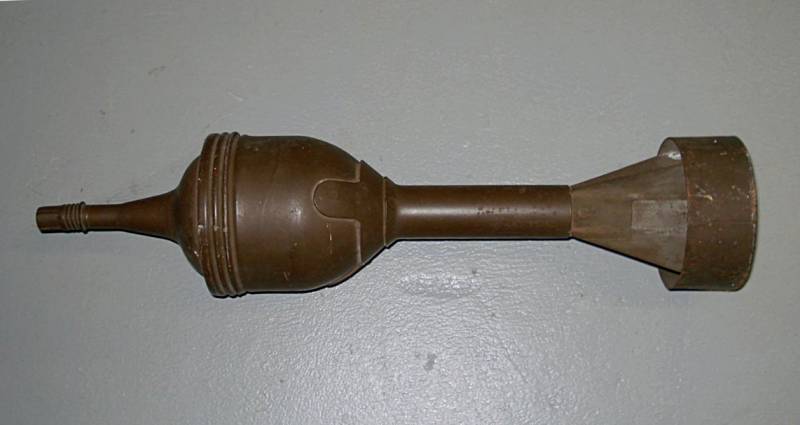
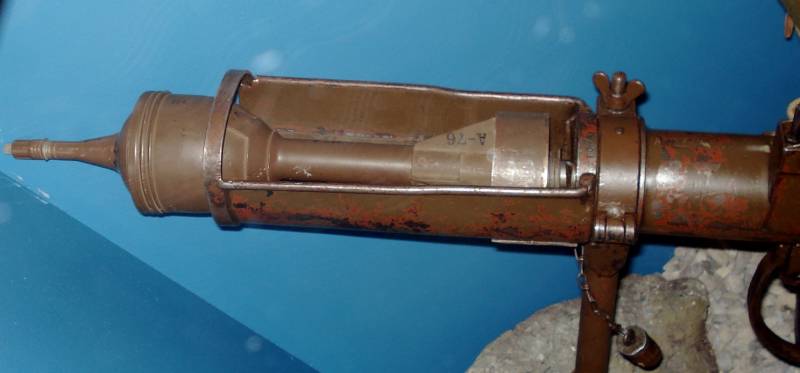
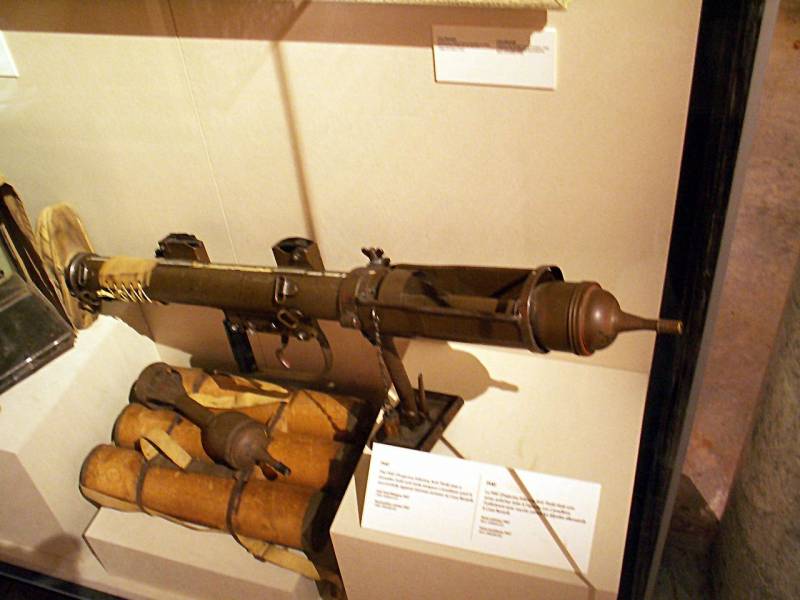
Information